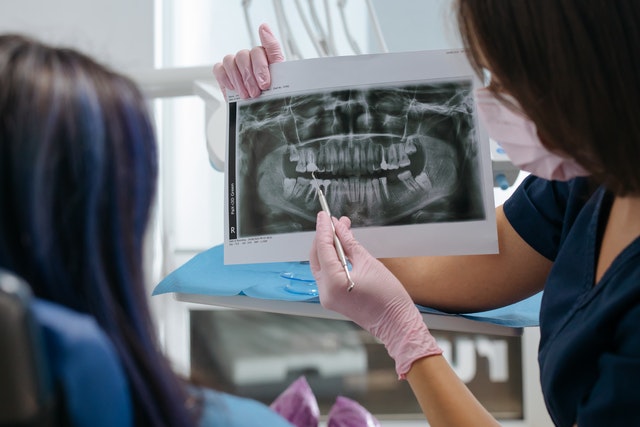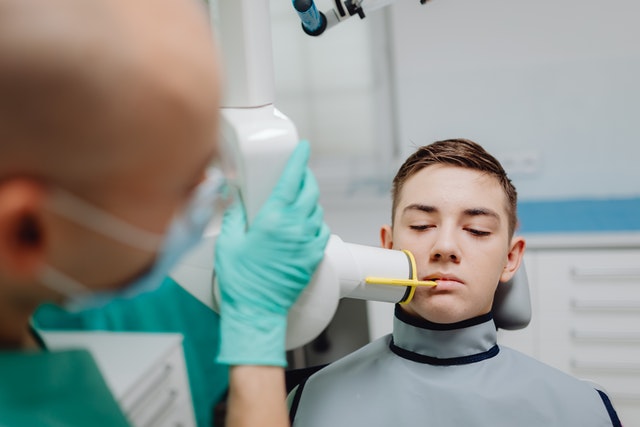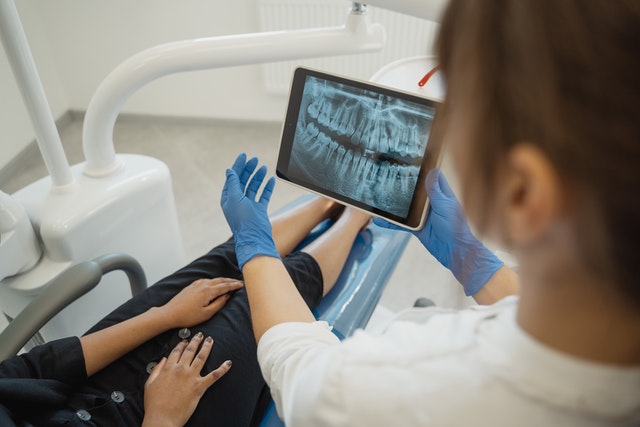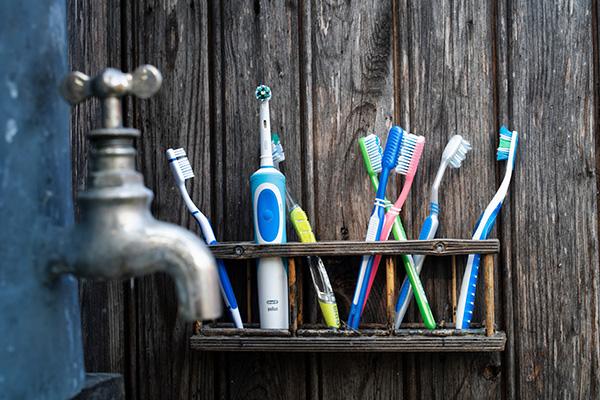The Complete Guide to Dental X-Rays
Dental x-rays play an important role in diagnosing oral health problems. Your dental professionals are skillfully trained in order to take the appropriate x-rays to better support you and your oral health.
This article will outline what dental x-rays are, the various types of dental x-rays, and why they’re so important in the world of dentistry.
Table of Contents
What Are Dental X-Rays?

X-rays, or radiographs, produce a narrow beam of photons in order to capture an image. The beam passes through the body producing a picture on a digital sensor or film.
The energy used in dental x-rays produces an image by how the body absorbs the x-ray. Less dense body parts will be darker while the dense body parts appear white.
In short, dental x-rays are a way for dentists to see exactly what is happening inside your mouth and inside all of your teeth. They are extremely important and common in the world of dentistry.
4 Most Common Types Of Dental X-Rays
X-rays are a great tool used by dental professionals to keep your smile healthy. They allow your dental team to detect problems in the mouth before any pain or infections occur.
The 4 most common types of dental x-rays are:
- Bitewings: These images are done routinely every 12-18 months at the dental cleanings. This is one of the main ways to diagnose cavities and involves 2-4 different images.
- Periapical: A periapical x-ray is an image that shows the whole tooth all the way down to the root. They are routinely done in full mouth series but are also used to diagnose any dental problems, like an infection.
- Panoramic: This x-ray is usually taken every 3-5 years. It shows the whole smile and facial structures. It is a great screening image for any pathology or abnormalities in the face.
- Full-Mouth Series: A series of x-rays that involves bitewings and periapical images make up a full-mouth series. Also called an FMX, these preventative images are done every 3-5 years.
Why Dental X-Rays Are Important

Dental radiographs are an important preventative and diagnostic service. X-rays help diagnose cavities, evaluate the bone level, check for any abnormalities, and see any plaque buildup called calculus (tartar).
The frequency of receiving dental x-rays depends on your oral health. High risk patients should have routine x-rays done once a year.
Are Dental X-Rays Safe?
Radiation is used in order to take an x-ray. A large amount of radiation is dangerous and can damage DNA and cells. Dental x-rays, however, use a very low amount of radiation that makes them safe to get routinely at the dental office.
Your dental professionals are trained to use x-rays in a safe matter using ALARA. This stands for As Low As Reasonably Achievable and is used to avoid exposure to radiation that does not have a direct benefit to you, even if the dose is small.
A lead apron will also be used to block the radiation from penetrating other parts of the body. Today’s technology uses digital sensors that require even less radiation that in the past. This makes dental x-rays safer than ever before.
The maximum annual dose allowed for radiation workers in the United States is 50 mSv. One set of four bitewing x-rays are around only .038 mSv. Panoramic x-rays are around only .025 mSv. These measurements can range based on the x-ray machine and the settings used.
So, are dental x-rays safe? Yes, absolutely. However, it is still recommended to have dental x-rays postponed if possible when pregnant, but they are considered safe to receive if necessary. Always let your dental team know if you are pregnant and of any other changes to your health.
Check out our Dental X-Rays When Pregnant article for more information.
Examples of Daily Sources of More Radiation Than X-Rays

X-rays use radiation to produce an image of the inside of the teeth and bone and can be dangerous when exposed to high levels. As outline above, the maximum annual dose allowed for radiation workers in the United States is 50 mSv.
Dental x-rays use a very low amount of radiation that makes them safe to use routinely at the dental office. It might help your fears to know that you’re actually exposed to radiation every day that is considered safe and acceptable.
Other sources of radiation that are higher than dental x-rays are:
- The Outdoors: Background radiation occurs naturally in the environment. The soil, sun, air, and water all expose you to radiation.
- Electronics: Cell phones, computers, lamps, and other electronics produce a small amount of radiation.
- Flying: You are exposed to radiation on each flight you take on an airplane. This is due to cosmic radiation from the sun, stars, planets, black holes, and asteroids in space.
- Food and Drinking Water: Food absorbs radiation from the soil used to grow it. It is also absorbed in drinking water and the water used to grow foods.
Recommendations
The benefits that come from dental x-rays greatly out number the minimal, and even non-existent, complications that could occur. X-rays are a great way to improve your oral health and catch problems early on.
Dentists have been using x-rays for a very long time and they are extremely important to the practice as a whole. Dental professionals are well trained and use x-ray machines safely every day.
We hope that this article has eliminated any fears you may have about dental x-rays and helped you better understand how safe and effective they are for maintaining a great smile.
Frequently Asked Questions
How often should x-rays be taken?
It is important for your oral health to have routine x-rays taken at the dentist. If you are at high risk for cavities or gum disease, x-rays should be taken at least every year. For lower-risk patients, it is recommended to have x-rays taken every 18 months.
Is a dental x-ray harmful?
Radiographs at the dentist are perfectly safe to have done routinely. The use of very low radiation energy combined with safety measures will protect you from any harm. X-rays are an important part of your dental health.
Take Home Smile Store
Visit our Take Home Smile store for educational brochures and other fun printables to help with oral hygiene. All products can be customized to fit your dental needs.




Before having her wisdom tooth extracted, my sister has been planning on getting a dental digital x-ray and she is anxious about it. It’s good that you mentioned how little radiation dental x-rays emit, making them safe to obtain regularly at the dentist’s office. I’ll be sure to let her know about this and look into dental practices that could be able to assist her with it. I appreciate you sharing!